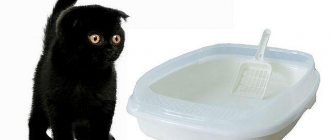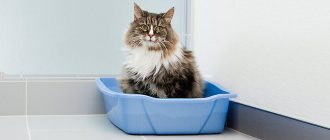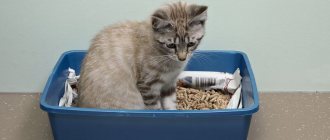9328Administration
A furry friend has appeared at home and you can admire him around the clock without taking your eyes off him. But, do not forget that he is a living creature and wants to eat, and then goes to the toilet. That is, you need to deal with them so that it does not darken the owner’s joy.
But what to do if the kitten does not go to the litter box, while demonstrating its protest to the indicated place every day? The pet does not walk and any owner will get tired of this, because he will need to be cleaned up regularly.
What prevents a kitten from understanding what a tray is for?
- Age
If a baby is taken from his mother at too early an age, even before she has shown him the purpose of the tray, he simply will not understand why this strange thing is in the corner. Up to 2 months, the mother cat “cleans up” after the children herself, and the baby himself will be at a loss: “Where does THIS all come from?!” But, since instinct tells him that THIS should not remain within the “nest”, the kitten will simply run away a certain distance and do its business wherever it feels like it - then the mother will clean up!
Often, a baby deprived of mother's milk becomes constipated, and the kitten does not go to the toilet for generally 2-3 days. What to do? If the period of “no pooping” drags on, then the baby needs to be given an enema and held in the tray so that he can empty his intestines in the right place, thereby taking the first step towards accustoming to the tray.
- Breed
Cats, close to nature, have an innate cleanliness. This is the law of survival in the wild: there should be no smell from a lurking predator - one, and it should be difficult to discover the location of its lair - two. That’s why cats bury their “internal waste” in the ground – they hide it. Question: “How to train a cat to use the litter box if it is an adult?” – occurs rarely and there must be good reasons for this. But in breeds that are “terribly far from the people,” such problems can often arise: the extinction of natural protective instincts is called. If over the course of many generations this or that instinct is not confirmed by the need for survival, it fades over time or is lost altogether.
- Fear
You know exactly what the cat tray is for, but the kitten is not familiar with this thing at all! This foul-smelling trough (the new plastic has a very specific smell) can cause elementary fear in the baby. And, of course, there is no reason for the kitten to want to trust this incomprehensible object. “Eagle pose” is the most vulnerable pose of animals. And you want the kitten to take this vulnerable pose right in this scary place for him?!
- Toys
This is the other side of the same question: “What is this thing?” By leaving your kitten to explore the litter box on his own, you may find that your kitten's litter box is used as a luxurious playground for play and relaxation. How could it be otherwise if these balls scatter and roll around the floor so well?! And then, after racing with the filler, it’s so nice to relax in this dry pool with balls!
- A matter of taste!
Once in a new home, a kitten has to get acquainted with many new things and smells. The food also changes, often taking the form of dense dry balls, which are very similar to the granules poured into a cat tray. It may not be as tasty, but it’s just as crunchy! And so the kitten eats the litter, mistaking it for a new type of food.
The second option is that the kitten’s teeth are changing, and he uses dry balls to scratch his itchy gums.
The third option is that a growing organism does not have enough minerals for further development, and this organism tries to make up for their deficiency in such an unconventional way. Kitty litter consists of clay and hard minerals and grain waste, so it is not surprising that the kitty litter box is turning from a litter box into an all-inclusive system.
Option four is one of the symptoms of developing rabies. This irreversible disease is characterized not only by aggressive behavior, as many people think, but by a multitude of symptoms! And one of them is when cats grab and eat completely inedible objects: stones, wood, litter for toilets, etc., etc.
All these actions must be stopped immediately! Such a “diet” threatens the death of your pet!
By the way, “A Matter of Taste” concerns all animals in the third and fourth points. What does the owner of adult cats and cats need to know if the cat does not go to the toilet specially placed for him?
Learned behavior
But “marks” can also play a cruel joke on the owners - after all, they remain where the cat has already done its business. That is, on the carpet or in the same slippers or shoes. And the shoes may well become a kind of “double” of the tray, and for obvious reasons. That is why it is so important to quickly eliminate the consequences of an accident. And not only in terms of cleanliness and hygiene, but in terms of eliminating the “beacon” smell. At one time, in response to a reader’s letter, we prepared a separate publication. Please take the time and read it, there is a lot of useful practical advice there.
Why doesn't the cat go to the toilet?
- They just weren't taught
If you picked up a cat from the street, where there was no need to keep clean in a confined space (inside the house, in an apartment), then you should not expect an instant revision of worldviews. It is extremely difficult to get rid of this “street influence”. Especially if the cat you got is capricious and doesn’t see the need to use the cat litter box. Well, the yard cat doesn’t want to go to the litter box - he’s a free tramp and that’s it!
- Hunting or spree
In this case, all your requests and punishments will lead to nothing, you just need to endure it or give your pet what he wants. During this period, animals become angry, capricious and touchy, especially cats.
Cats begin to ignore the cat tray, leaving odorous puddles not only in the corners of the corridor, but also on soft objects - carpets, sofas, pillows, etc. These objects are most heavily saturated with liquid and retain the odor call longer: “I’m here!” I'm calling you! Come!!!"
If this does not help, then the cat begins to be mischievous and shit not in the tray, but shit next to it. The last attempt to reach a distant loved one will be to “hang a notice” on the owner’s shoes, which he wears on the street, and to make more puddles at the front door.
The “hunting” cat does almost the same thing. True, the behavior of a stud cat in the house is more radical. He marks constantly, and these marks have nothing to do with teaching the cat to go to the litter box. This is a constant call of nature: the cat is ready to reproduce every day, every hour, every minute. “Play my hormone” - this is what makes a healthy sexually mature animal lift its tail at every corner, wall, table leg, side of a chair, etc. And if the cat senses that somewhere nearby (within 1.5 km) a calling cat is walking, and he is forced to sit in a closed space of a house or apartment, then the cat begins to have attacks of claustrophobia like a cat. During these attacks, the cat shits next to the litter box, although before claustrophobia he was a decent cat, accustomed to cleanliness, the number of smelly marks increases significantly, and puddles can appear in the most unexpected places, even on window sills and tables.
- The animal is sick
The reasons why the cat does not go to the toilet, or the cat has stopped going to the litter box, can be varied, but first of all you need to pay attention to the health of the pet. You can't fix a problem without finding out the reasons. The reason may be:
- diseases of the urolithiasis and kidneys;
- disorders of the gastrointestinal tract;
- presence of endoparasites.
If your pet begins to often sit down next to the tray, staying in this position for a long time, or taking this position on soft surfaces, then most likely you need to pay a visit to the veterinarian. The animal walks past the tray because it associates the tray with pain.
- Psychological and mental disorders
It is not difficult to toilet train a kitten and maintain this clean habit in an adult animal, if it is mentally healthy. It is much more difficult if there are mental disorders. Then your entire training of the kitten to the litter box will come down to how quickly the animal managed to forget the newly acquired skill. This will continue indefinitely and no punishment will help here. Answer to the question: “Why doesn’t the kitten remember where to do its business?” - a good doctor can give, because... It is impossible to independently determine this reason. If the cause is removable, then the doctor will help with the selection of medications and advice on how to accustom the kitten to the litter box.
Another reason why a cat began to ignore the cat toilet is the incorrect behavior or indifference of the owners. For example:
- prolonged loneliness;
- entrusting the care of an animal to other, unfamiliar persons;
- the appearance of a new cat;
- purchasing another pet;
- birth of a newborn in the family.
A possible reason why a cat has ceased to be clean and does not go to its “native” litter box may be the elementary physical weakness of an old animal, when it is simply not possible to “carry” urine or feces to the litter box - senile incontinence. Forcing an old cat to strictly fulfill its duties to you through punishment is simply cruel to someone who has been your friend and companion for many years. Believe me, the animal itself experiences the “accident” much more deeply than you!
- Shyness
Although many people tend to give their pets human character traits, humanizing their thoughts and actions, which only spoils the correct relationship between cats and their owners, it is worth recognizing that they still have some “human” oddities. And among them is a trait that can easily be mistaken for modesty.
How to toilet train a kitten if it refuses to pee and poop in front of an “amazed public”? Force? How?! - No way. You will either have to move the tray out of sight, or splurge on a closed tray-house for cats.
Psychological reasons
This group includes any factors affecting the psychological state of the animal. In addition to severe stress and other emotional turmoil, an unfamiliar smell can cause a dislike of the bathroom.
Didn't like the new tray or filler
If you recently changed the tray to a different model, then most likely it’s all about the strong smell of plastic and the absence of cat marks. Also, the pet may be confused by the appearance of the product if the purchased toilet is fundamentally different from its previous version.
Read also: Why do people die in their sleep?
Changing the filler also evokes similar feelings. Flavored options are only good for humans. Mustached pets smell much more keenly, so the scent of flowers only scares them away.
Dissatisfaction may also be explained by the consistency of the filler. Highly absorbent silica gel granules crunch very loudly when instilled, causing fear or irritation to the animal.
Rearranging the place where the pot is located
Small changes or major renovations to the washroom can be a big turn-off for your pet. Combining a toilet with a bathroom is especially difficult. Most cats hate water, so moving their potty to a potentially dangerous location will feel like a challenge to find a new litter box in another part of the house.
The appearance of a new smell in the cat's latrine
Another reason for the appearance of a new smell is moving. Having lost its usual trail, the cat simply will not understand where exactly it should go to the toilet.
Your pet may also be put off by an automatic air freshener. Unlike the usual one, it will leave a pleasant aroma in the room on a permanent basis. Despite its convenience, this device can cause allergies or severe stress in your pet due to sudden spikes.
Being distracted by a sharp sound at a crucial moment is not the most pleasant development of events. Don’t be surprised if the cat will bypass the toilet with this scary device a mile away - and do its business behind a more harmless sofa.
Lack of privacy
The location of the toilet plays a significant role. It’s easy to understand that it’s very, very difficult to concentrate when people are constantly looking at you or distracted by extraneous sounds. An open door, noisy company and proximity to household appliances are not the best solution for comfortable emptying of the bladder.
Revenge, resentment, severe stress
By defecating past the tray, animals take revenge for an insult. If you raised your hand to your pet or scolded it after several hours from the moment of committing a bad act, then it will only remember your cruelty. Such parenting methods never bring anything good, so try to abandon them so as not to spoil the relationship.
Another possible cause of resentment is lack of attention. Owners who spend a lot of time at work often forget to play with their pets. And if another pet or child appears in your home, then the existing resentment will only increase.
The choice of a more secluded corner can also be explained by severe stress. It occurs when changing place of residence, after a recent trip to the veterinarian or an unpleasant hygiene procedure. The cat may also be worried about a large number of strangers gathered in the house.
How to choose the right litter box for your cat
Cat litter boxes are:
- The simplest plastic container
This is a trough, most often rectangular with rounded corners. The troughs are economical, accessible to all segments of the population and are favorably accepted by cats. These trays are pleasing to the eye with a variety of colors and are easy to wash and use. Disadvantage: cannot be used without filler.
- Trough-tray with mesh
The same container, only supplemented with a plastic drainage mesh grid, which can be attached either to the sides or inserted inside on legs. The filler is required depending on the wishes, urine easily seeps down, and solid waste remains on the mesh and is easily disposed of.
The disadvantages of a tray with a mesh are that it must be washed after each use; when trying to bury traces of its own vital activity, the cat can catch its claws on the mesh and tip the contents of the tray onto the floor.
- Tray with high sides
It justifies itself completely, especially if the pet is large and strong. A tray with removable sides that secure insert bags, which are easy to remove and throw away along with the contents. The additional package includes the same drainage grid as for the trough.
There is only one minus - such a vessel is not suitable for a kitten: the sides are too high.
- Tray house
A godsend for shy cats! The house, which looks like a closed carrier, is a real cat bio-toilet, where the cat can quietly retire to perform the desired action. In addition, it eliminates the risk of “inaccurate hits” and prevents the spread of aromas. Disadvantages - to wash, you need to take it apart - one, cumbersome for a cozy corner of “introspection” - two, cats often mistake it for a real house for relaxation - three.
- Automatic toilet
This is truly a miracle of engineering genius, providing a carefree life for cat owners. Self-cleaning, wet cleaning, disinfection, no odors, practically no maintenance - a lot of advantages!
The downsides are: special means for maintaining cleanliness, connection to water supply and electricity, noise made when washing, high price. And the biggest drawback is that cats are almost universally afraid of noisy toilets and do not want to shit there. And how to teach a kitten to go to the litter box, pray tell, if he is simply afraid of it?!
No, you need to start toilet training with an ordinary tray - it’s inexpensive, and in the category: “Which tray is better?” it has clear advantages.
Changing the filler
Cats are big conservatives. Even when it comes to tray filler. And then, as luck would have it, you couldn’t find what you needed in the nearest store, so you purchased a similar one. Wow, the squeamish pet sniffed it and decided that it didn’t suit him. While the owner finds and brings the usual one, he will do his business wherever he needs to. We are not talking about changing the type of filler (switching, for example, from wood to clay). Advice: never unnecessarily change a filler that works well.











